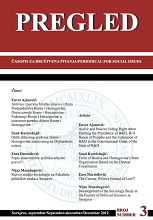Filozofija slikarstva: Slike doba – Mersad Berber
The Philosophy of Painting: Painting the Ages – Mersad Berber
Author(s): Abdulah ŠarčevićSubject(s): Philosophy
Published by: Univerzitet u Sarajevu
Keywords: Mersad Berber's philosophy of painting; graphics and image; the memory of the Book of Sand (Borges); truth's self-styling; the opening of the world; M. Berber as a poet; those who give a measure to their own time; openness to truth; suffering and death
Summary/Abstract: The West is undergoing the process of discovering that meticulous artisan brush stroke of Mersad Berber - painter and graphic artist, with the possibility of endless pre-appearing or continuing. As if behind every cycle there is an “invisible time labyrinth” that invokes centuries and eras like , for example that one of the orphic mirror of the old Kastel in Banja Luka, Skender Vakuf, Bosanski Petrovac and so forth. We meddle with admiration in that silent life of faces which are enchanting, meek and melancholic, calmed and wonderful in their enigmatic element. It seems that the world of endless time arrays which are at some time simultaneous past, present and future, was disturbing the painter/thinker, that intricate play , hermeneutic shading. That is, as it has been always known, even that Borges‟ network of divergent, convergent and simultaneous times. The times that have not been meeting each other, or never known which are now in communicative union. It seems that for Mersad Berber painting was a life form, including the esthetic vindication of life in its complete dramaturgy. He was finding his joy in being the connoisseur of feminine characters, faces, ladies, in the game of light and dark - a deeper participating in the life, not just in history that never prostrates it. His paintings presented the Good in its purest form. The philosophy names it the cosmic union – everywhere with a bit of counterpoint. With his characters, colors and atmospherically Berber created the music or in a Berber‟s way. The joy in existence is getting multiplied and elevated. These were Berber‟s strengths as a creator. Even in his case, I dare say that art is the only form of proto-destiny in Malraux‟s sense - the only manner to differently compose changes in painting, rather than in music. From his paintings, almost in Platonesque sense, we conceive that element which precedes the existence, a melancholic color in his characters, a petrified fugue, music transformed in brush strokes, the music without the beginning or end. They are fascinating since they have that large controversy which is more a question‟s yawn than reply‟s tranquility. In days when multiple riddles of the world, Europe, Bosnia, Asia begin appearing on the horizon, we are becoming cognizant of Berber‟s full awareness of painting paradox: to resolve the irresolvable, to make the invisible visible, to condense the time on the canvass. It is not about the mobility in the circle of people engaged in politics or sociology, but in the zones of existentialism in its broadest conceiving. Camus expresses it as it follows: Expectancy that is asserted in front of us is delivering the words of hope. It is true that our generation has never demanded anything but a single thing: to rise to the level of despairing. However, it may have us prepared to talk about the noblest hope, the hope appearing victorious that we search for through the misery of the world.
Journal: PREGLED - časopis za društvena pitanja
- Issue Year: LIII/2012
- Issue No: 3
- Page Range: 1-50
- Page Count: 50
- Language: Bosnian

